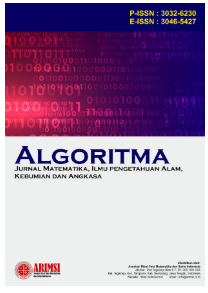Pengembangan E-Modul Berbasis Discovery Learning Berbantuan Canva pada Materi Reaksi Reduksi dan Oksidasi
DOI:
https://doi.org/10.62383/algoritma.v3i1.386Keywords:
Development researchAbstract
The purpose of this research is to create e-module teaching materials with a discovery learning approach on the topic of oxidation-reduction reactions. These materials will be assessed for validity, practicality, and effectiveness in educational settings. This research uses the assurance development model which includes student character analysis, identification of learning objectives, selection of appropriate methods, media, and materials, utilization of media and materials in the learning process, active involvement of students, and evaluation phase. The e-module has successfully undergone a rigorous validation process conducted by a panel of validators and respected experts in the field. In addition, it has been thoroughly field tested to ensure that the resulting e-module is valid and effective, as well as practical in its application. The results showed that: 1) the assessment of media validity by media and material experts is included in the very valid category; 2) at the field trial stage involving 17 students of class X MIA 1 SMA Muhammadiyah Maumere, the class completeness rate was 81.3%. In addition, the electronic module (e-module) has been found to have a beneficial effect on student learning outcomes. Based on the descriptive analysis results, it can be concluded that the average student learning completeness rate is 87%. This indicates that e-modules used in an educational setting can be considered effective. The e-modules received positive responses from both students and teachers, indicating their practicality.
Downloads
References
Arsyad, A. (2015). Media pembelajaran. Jakarta: Raja Grafindo Persada.
Chang, R. (2010). Chemistry 10thEdition. New York: Mc Graw Hill.
Darmadi. (2017). Pengembangan Model dan Metode Pembelajaran dalam dinamika belajar siswa. Yogyakarta: Deepublish.
Hosnan, M. (2016). Pendekatan Saintifik dan Kontekstual dalam Pembelajaran Abad 21. Bogor: Ghalia Indonesia.
Mardikaningtyas. (2016). Pengembangan Pembelajaran Pencemaran Lingkungan Berbasis Penelitian Fitoremediasi untuk menunjang Ketrampilan Ilmiah, Sikap Peduli Lingkungan dan Motivasi Mahasiswa pada Matakuliah Dasar-Dasar Ilmu Lingkungan. Jurnal Pendidikan: Teori, Penelitian Dan Pengembangan, 1(3).
Martin, F. (2013). Development of an Interaktive Multimedia Instructional Module. The Journal of Applied Instructional Design, 3(3).
Pamularsih, B., Haryanto, S., Selatan, K. (2020). Pengembangan E- Modul Kimia Berbasis Discovery learning pada Pokok Bahasan Koloid. Journal of Educational Evaluation Studies (JEES), 1(2).
Priliyanti, A., Muderawan, I. W., & Maryam, S. (2021). Analisis Kesulitan Belajar Siswa Dalam Mempelajari Kimia Kelas XI. Jurnal Pendidikan Kimia Undiksha, 5(1).
Putri Rinaningsih. (2021). Handout Digital pada Masa Pandemi dalam Pembelajaran Kimia. Chemistry Education Review, 4(2).
Shoimin, A. (2016). Model Pembelajar Inovatif dalam kurikulum 2013. Yogyakarta: Ar- Ruzz Media.
Sofiana, Teguh, W. (2019). Pengembangan Modul Kimia Socio- Scientific Issues (SSI) Materi Reaksi Reduksi Oksidasi. Journal of Educational Chemistry (JEC), 1(2).
Suharsimi Arikunto. (2018). Prosedur Penelitian Suatu Pendekatan Praktek. (Jakarta : PT. Rineka Cipta.
Suryaningsih. (2010). Pengembangan Media Cetak Modul sebagai Media Pembelajaran Mandiri. Jakarta: Salemba Empat.
Downloads
Published
How to Cite
Issue
Section
License
Copyright (c) 2025 Algoritma : Jurnal Matematika, Ilmu pengetahuan Alam, Kebumian dan Angkasa

This work is licensed under a Creative Commons Attribution-ShareAlike 4.0 International License.





